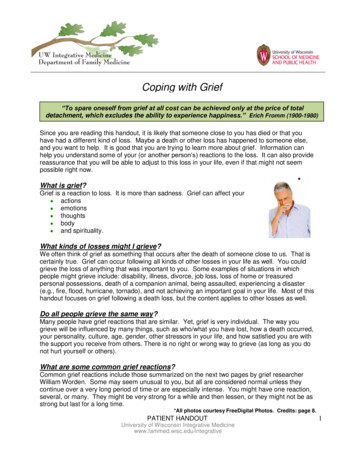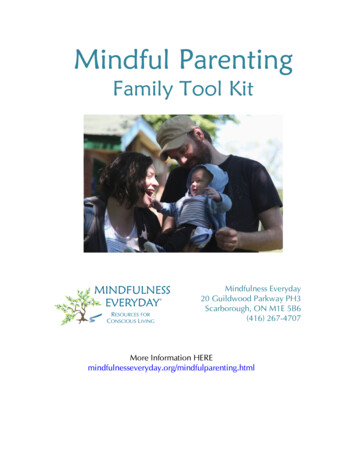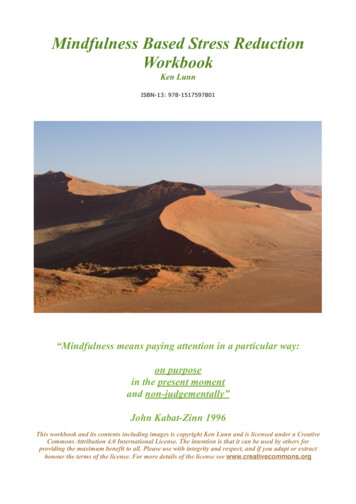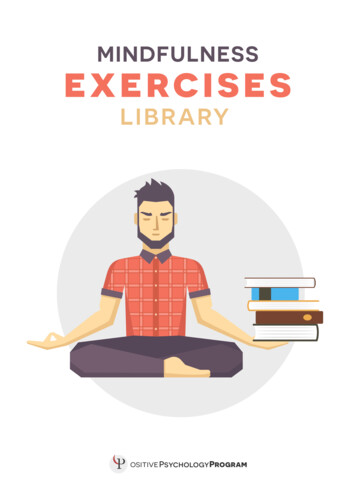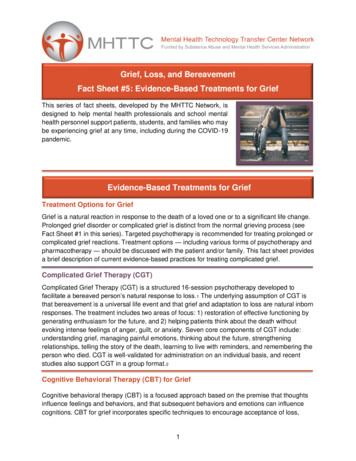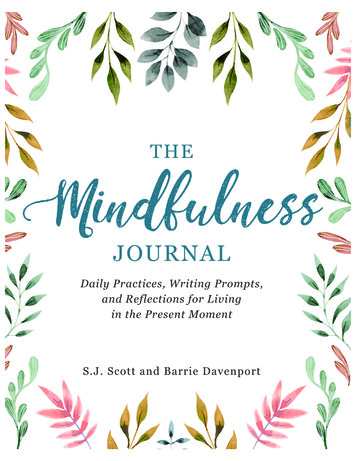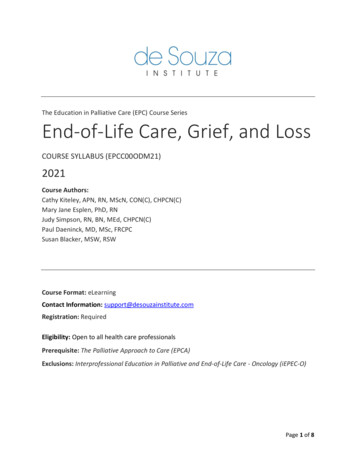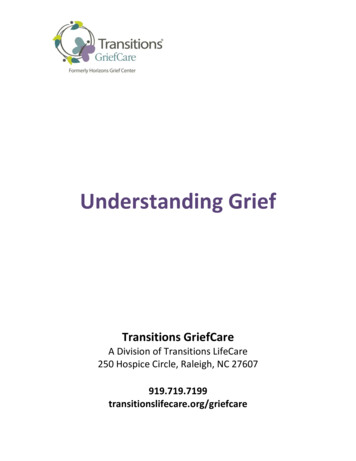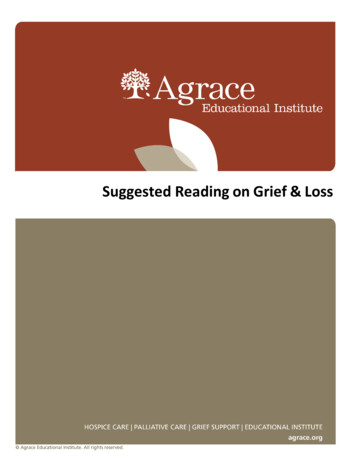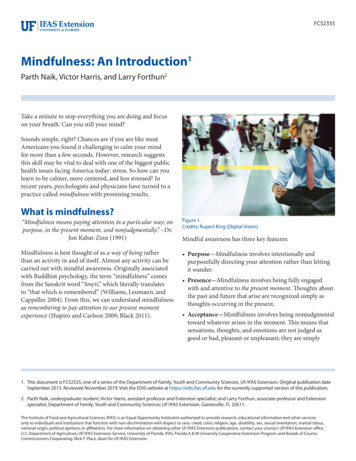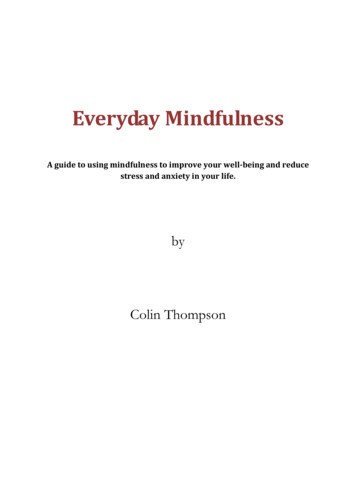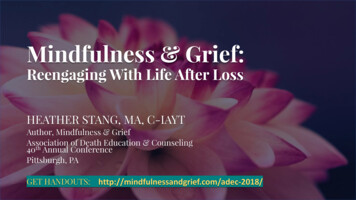
Transcription
Mindfulness & Grief:Reengaging With Life After LossHEATHER STANG, MA, C-IAYTAuthor, Mindfulness & GriefAssociation of Death Education & Counseling40th Annual ConferencePittsburgh, PAGET HANDOUTS:http://mindfulnessandgrief.com/adec-2018/
Session Objectives Explain how mindfulness practices, including present momentawareness and compassion, can be used to relieve physical andemotional suffering. Outline specific meditation, yoga, and guided journaling techniquesthat enhance the ability to connect with the body’s wisdom. Review case studies that illustrate how the practice of mindfulnessmeditation and yoga contributes to meaning making andposttraumatic growth.
Mind Full or Mindful?
MINDFULNESS IS . the practice of being fully present and alive,body and mind united. Mindfulness is theenergy that helps us to know what is going onin the present moment.Thich Nhat Hanh ect/
MINDFULNESS IS .The awareness that emerges through payingattention on purpose, in the present moment, andnon-judgmentally to the unfolding of experiencemoment to moment.Jon Kabat-Zinn (2003)
Mindfulness Is Not Just Seated Meditation 6 TIONWALKINGMANTRA*Mindfulness is still an option!
The Brain on Mindfulness Lateral Prefrontal Cortex: Assessment Center Medial Prefrontal Cortex: Me Center – Empathy Insula: Gut Feelings Amygdala: Fear Center Shrinks Neocortex: Creativity
Suffering Pain x ResistanceShinzen Young (1994)
5 Domains ofPosttraumaticGrowth Increased Appreciation of Personal Strength Sense of New Opportunities & Possibilities Deepened Sense of Connection & Compassion Appreciation of Life in General Spiritual or Religious ChangeCalhoun & Tedeschi (2006)
Relevant Articles & Research Cacciatore, J., & Flint, M. (2012). ATTEND: Toward a mindfulnessbased bereavement care model. Death studies, 36(1), 61-82.(A)ttunement, (T)rust, (T)herapeutic touch, (E)galitarianism (N)uance, and (D)eath education Hofmann, S. G., Sawyer, A. T., Witt, A. A., & Oh, D. (2010). Theeffect of mindfulness-based therapy on anxiety and depression: Ameta-analytic review. Journal of consulting and clinicalpsychology, 78(2), 169. 39 studies, 1,140 participants
Relevant Articles & Research Philbin, K. (2009). Transpersonal integrative yoga therapy: aprotocol for grief and bereavement. International Journal of YogaTherapy, 19(1), 129-141. Non-significant, however positive leaning, improvement in theSatisfaction with Life Scale Telles, S., Naveen, K. V., & Dash, M. (2007). Yoga reducessymptoms of distress in tsunami survivors in the AndamanIslands. Evidence-based complementary and alternativemedicine, 4(4), 503-509. All reported a significant reduction in self-rated fear, anxiety,sadness, and disturbed sleep after the one week program.
8 Week Online Course & Alumni Group
Module 1:Focusing &ConsciousRelaxation Counting The BreathMy Mantra MeditationBreath Focus MeditationThree Part BreathRelaxation for Anxiety, Grief & StressInformal Practice: Good Sleep Hygiene
Module 2:MindfulAwareness Body ScanMindfulness of BreathMindfulness of Breath, Body & SoundsPhoenix Rising Therapeutic YogaMindfulness of Everyday TasksMindful Awareness Break
Module 3:CompassionFor Yourself& Others Metta MeditationAffectionate BreathingHeart Center MeditationWake Up With Self-CompassionWell Wishes on the Spot
Benefits of Self-Compassion Less Anxious & Depressed (Neff, 2009) Fewer Negative Emotions (Neff, Rude, Kirkpatrick, 2007) Higher Emotional Intelligence (Leary, Tate, et al., 2003) Emotional Coping Skills (Rockliff, Gilbert, et al. 2008) Reduces Avoidance In PTSD (Thompson, Waltz, 2008) Less Resistance to Suffering (Neff, 2003)
Meditation Can HelpBereaved People &Professionals: Start Sleeping Again Relieve Physical Tension & Increase ImmuneFunctioning Self-Soothe to Calm Anxiety, Racing & WorriedThoughts Feel More Caring Towards Self & Others Establish a Continuing Bond With the Person whoDied Develop life-long Coping Skills Cultivate Posttraumatic Growth
References & Resources Benson, H. & Klipper, M. Z. (1992). The relaxation response. Harper Collins, New York. Benson, H. & Proctor, W. (2010). Relaxation revolution: The science and genetics of mind body healing. Simon and Schuster. New York. Brach, T. (2013). Radical acceptance: Embracing your life with the heart of the Buddha. Bantam, New York. Cacciatore, J., & Flint, M. (2012). ATTEND: Toward a mindfulness-based bereavement care model. Death studies, 36(1), 61-82. Calhoun, L. G., & Tedeschi, R. G. (Eds.). (2014). Handbook of posttraumatic growth: Research and practice. Routledge. Hanson, R. (2009). Buddha’s Brain. New Harbinger, Oakland. Hanson, R. (2013). Hardwiring happiness: The new brain science of contentment, calm, and confidence. Harmony. Helbert, K. (2015). Yoga for Grief and Loss: Poses, Meditation, Devotion, Self-Reflection, Selfless Acts, Ritual. Singing Dragon. McGonigal, K. (2016). The upside of stress: Why stress is good for you, and how to get good at it. Avery. Neff, K. (2011). Self-Compassion: The proven power of being kind to yourself. William Morrow: NY, NY. Neimeyer, R. A. (Ed.). (2015). Techniques of grief therapy: Assessment and intervention. Routledge. Sausys, A. (2014). Yoga for grief relief: Simple practices for transforming your grieving body and mind. New Harbinger. Shapiro, S. L., & Carlson, L. E. (2009). The art and science of mindfulness: Integrating mindfulness into psychology and the helping professions. American PsychologicalAssociation. Stang, H. (2014). Mindfulness & grief: With guided meditations to calm your mind & restore your spirit. CICO Books: London. Treleaven, D. (2018). Trauma-sensitive mindfulness. W.W. Norton & Co. Kabat‐Zinn, J. (2003). Mindfulness‐based interventions in context: past, present, and future. Clinical psychology: Science and practice, 10(2), 144-156.
Heather Stang, MA, lnessandgrief.com240-397-8080Twitter: @heatherstangma
Mindfulness & Grief: Reengaging With Life After Loss HEATHER STANG, MA, C-IAYT Author, Mindfulness & Grief Association of Death Education & Counseling 40th Annual Conference Pittsburgh, PA . Jon Kabat-Zinn (2003) MINDFULNESS. M
